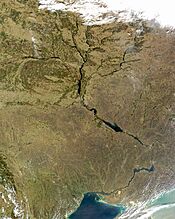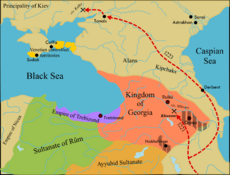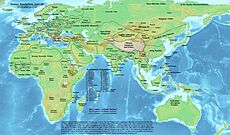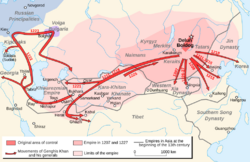Battle of the Kalka River facts for kids
Quick facts for kids Battle of Kalka River |
|||||||
|---|---|---|---|---|---|---|---|
| Part of the Mongol invasion of Kievan Rus' | |||||||
 Mongol horse archers |
|||||||
|
|||||||
| Belligerents | |||||||
| Mongol Empire Brodnici |
Principality of Kiev Principality of Galicia-Volhynia Principality of Chernigov Principality of Smolensk Cumans |
||||||
| Commanders and leaders | |||||||
| Jebe Subutai Ploscânea |
Mstislav Mstislavich Mstislav III (POW) Daniel of Galicia (WIA) Mstislav II Svyatoslavich † Khan Köten |
||||||
| Strength | |||||||
| 20,000–23,000 men | 8,000–80,000 | ||||||
| Casualties and losses | |||||||
| Unknown | Around 60–90% of Coalition force killed. | ||||||
The Battle of the Kalka River was a major fight on May 31, 1223. It happened near the Kalka River in what is now Ukraine. The battle was between the powerful Mongol Empire and a group of armies from different Kievan Rus' regions, like Kiev and Galicia-Volhynia, along with their allies, the Cumans. The Mongol generals Jebe and Subutai led their forces to a big victory. This battle was a tough loss for the Rus' and Cuman armies.
After the Mongols conquered a large empire in Central Asia, their generals Jebe and Subutai led a scouting mission. They traveled through the Caucasus mountains and defeated local tribes. They also fought the Cumans, a nomadic people. The Cuman leader, Khan Köten, asked his son-in-law, Mstislav Mstislavich of Galicia, for help. Mstislav the Bold then convinced other Rus' princes, including Mstislav III of Kiev, to join forces against the Mongols.
At first, the combined Rus' army had a small win against a Mongol scouting group. The Rus' chased the Mongols for several days, but the Mongols were actually pretending to retreat. This made the Rus' armies spread out. The Mongols then turned around and formed their battle lines by the Kalka River. Mstislav the Bold and his Cuman allies attacked the Mongols without waiting for the rest of the Rus' army. They were quickly defeated. Many other Rus' princes were also beaten in the confusion. Mstislav of Kiev had to retreat to a fortified camp. After three days, he surrendered, believing he and his men would be safe. But the Mongols killed them all, including Mstislav of Kiev. Mstislav the Bold managed to escape. The Mongols then returned to Asia to rejoin their main army.
Contents
Why the Battle Happened
Mongol Expansion and Scouting
In 1219, the Mongol leader, Genghis Khan, invaded the Khwarezmian Empire. This was because his ambassadors had been killed. Over three years, Genghis Khan's armies destroyed the Khwarezmian Empire. Its ruler, Ala ad-Din Muhammad, died on an island.
Two Mongol generals, Jebe and Subutai, were chasing Muhammad. After he died, Jebe asked Genghis Khan if they could explore more lands. He wanted to return to Mongolia through the Caucasus mountains. While waiting for an answer, Jebe and Subutai led their army of 20,000 men. They traveled through Persia, attacking cities like Rey and Zanjan. The city of Hamadan surrendered without a fight. Another leader, Özbeg, saved his city, Tabriz, by giving the Mongols money and horses.
The Mongols then set up their winter camp in the Mugan Steppes. More fighters, like Kurds and Turcomans, joined their army there.
Raids in the Caucasus
Jebe and Subutai then turned their attention to the Kingdom of Georgia. In early 1221, they raided Georgia. Their goal was to take valuable goods, not to conquer the land. The Georgian King, George IV, fought back with 10,000 men. He pushed the Mongols away from Tbilisi. The Mongols pulled back but kept attacking the Georgian army.
In March 1221, the Mongols returned to Azerbaijan. They attacked the city of Maragheh. They used prisoners to lead the attacks on the city walls. They captured the city and killed most of its people. Jebe and Subutai thought about attacking Baghdad, but instead, they went back to Hamadan. This time, the city fought back hard. The Mongols suffered many losses before capturing and looting the city.
Later in 1221, the Mongols went back into Georgia. A large Georgian-Armenian army of 30,000 men gathered near Tbilisi. The Mongols also had 30,000 soldiers, plus help from local tribes. Jebe set a trap with 5,000 men. The main Mongol army pretended to run away. The Georgian cavalry chased them and fell into Jebe's trap. The Georgian army was badly defeated at Khunan. King George was seriously hurt. The Mongols then looted southern Georgia.
Getting Ready for Battle
Genghis Khan finally gave Jebe permission to continue his expedition. Jebe and Subutai then moved towards the city of Derbent. The city refused to surrender. Jebe promised to spare the city if they provided 10 guides through the Caucasus mountains. To make sure the guides were honest, the Mongols killed one of them. Crossing the Caucasus was hard for the Mongols. They lost many men and had to leave behind their heavy equipment because of the cold.
After crossing the mountains, the Mongols met a large army of about 50,000 men. This army was made up of different tribes like the Lezgians, Alans, and Cherkesses. The Cumans, a powerful Turkic people, also joined this alliance. Their land stretched from Lake Balkhash to the Black Sea. The Cumans also convinced the Volga Bulgars and Khazars to join. The Cuman leader, Khan Köten, put his army under his brother, Yuri, and his son, Daniel.
The first fight between this alliance and the Mongols was not decisive. But the Mongols were clever. They convinced the Cumans to leave the alliance. They reminded the Cumans of their shared Turkic roots with the Mongols. They also promised them a share of the treasures taken from the Caucasian tribes.
Once the Cumans left, the Mongols attacked the remaining alliance army and defeated them. Then, the Mongols turned on the Cumans. The Cumans had split into two groups on their way home. The Mongols destroyed both armies and killed all the prisoners. They then looted the city of Astrakhan. The Mongols began chasing the Cumans towards the northwest.
The Venetians, who were traders, made a deal with the Mongols. The Mongols agreed to destroy any other European trading posts they found. As the Mongols chased the Cumans, they sent a group to Crimea. There, the Genoese, another trading group, had stations. The Mongols captured and looted the Genoese city of Soldaia. Meanwhile, Khan Köten fled to his son-in-law, Mstislav Mstislavich of Galicia. Köten warned Mstislav that the Mongols would take their land next.
At first, the Rus' princes ignored the Cumans. They had suffered from Cuman raids for many years. But when news reached Kiev that the Mongols were moving along the Dniester River, the Rus' decided to act. Mstislav the Bold gathered an alliance of Rus' princes. This included Mstislav III of Kiev and Prince Yuri II of Vladimir-Suzdal. The Rus' princes then started gathering their armies and moving to a meeting point.
The Battle Begins
First Moves and Mongol Strategy
The exact number of soldiers in this battle is not known for sure. Historians have different ideas. Some say the Rus' army had 30,000 or even 80,000 men. Others believe it was much smaller, perhaps around 8,000 to 15,000 soldiers. The Mongol army is estimated to have been around 20,000 to 23,000 men. Many historians now think the Mongols had more soldiers than the Rus'.
The Mongols knew the Rus' army was moving. The Mongols were on the east side of the Dnieper River. They were waiting for more soldiers from Jochi, Genghis Khan's oldest son. But Jochi was sick, so no reinforcements came.
The Rus' tried to trap the Mongols. The princes of Galicia and Volhynia moved their armies south along the river. The princes of Kiev and Chernigov moved north. The army of Kursk came from the front. At the same time, the Cumans tried to attack the Mongols from behind. When Jebe found out, he sent 10 messengers to the Prince of Kiev. The messengers said the Mongols had no fight with the Rus'. They claimed they were only attacking the Cumans and were moving east, away from Rus' cities. But Mstislav of Kiev had the messengers killed. The Mongols then sent new messengers, who declared war.
When Jebe and Subutai heard about the Rus' movements, they started moving east. This was the only direction they could go. But they left a small group of 1,000 soldiers behind. This group was led by an officer named Hamabek. Their job was to watch the Rus' movements and act as bait. Soon, Mstislav the Bold reached the river opposite this Mongol group. It became clear that no single prince was in charge of all the Rus' armies. So, each prince could do what he wanted. Mstislav crossed the river under heavy arrow fire. When the Rus' landed, they had too many soldiers. The Mongol group was completely wiped out.
The Main Attack

The Mongols led the Rus' armies on a chase for nine days, pretending to run away. This made the Rus' armies spread out. Then, the Mongol army turned to face their pursuers along the Kalka River. The exact location of this river is not known today.
The old Russian stories about the battle don't give many details. They say which princes fought and which ones died. But they don't say how many soldiers were there or how many were hurt. The stories also say that the Cumans ran away very quickly. Their flight caused a lot of confusion among the Rus' soldiers. This led to many Rus' soldiers being killed by the Mongols.
Rus' Defeat
The Mongols attacked the combined Rus' and Cuman army when most of it had crossed the Kalka River. The Mongols seemed to surprise them. They quickly switched from shooting arrows while riding horses to charging with many cavalry. The Rus' forces at the back had not even reached the battlefield when the front lines started to break apart. The armies from Volhynia and Kursk made a gap in their line. This was so the fleeing Cumans could get through. But the Mongol heavy cavalry charged right through this new gap. They also surrounded the Rus' soldiers.
The army from Chernigov did not know the battle had started. They were moving forward when they crashed into the retreating Cumans. The Mongols used smoke bombs to make it harder for the Rus' to work together. The Mongol cavalry took advantage of the confusion in the Chernigov line and attacked. This caused the line to collapse. Prince Mstislav of Chernigov was killed.
At the same time, the Mongol forces on the sides closed in around the broken Rus' army. This cut off their escape. The surrounded Rus' soldiers were hit by many arrows. Mongol cavalry also charged wherever they saw a weak spot. While the Mongols were destroying the Rus' army, some soldiers, led by Mstislav the Bold, managed to fight their way out of the Mongol circle and escape. Mstislav of Kiev arrived to see the rest of the Rus' army running away. With his 10,000 men, he retreated to his fortified camp on a hill near the Dnieper River. The Mongols chased them and began to attack the camp.
What Happened After
The Battle of the Kalka River was a very costly defeat for the Rus' princes. Some historians say the Rus' lost 50,000 men. The Mongols lost very few soldiers. Most of the Rus' and Cuman forces were trapped with the river behind them, so they could not escape easily. Only Mstislav the Bold was able to save some of his army. Old Russian stories say that only 1 out of 10 soldiers made it back home. This means almost the entire army was lost. Prince Daniel of Volhynia, who was hurt, and Mstislav the Bold managed to escape. This battle was a big loss because many Rus' regions lost most of their soldiers.
The Mongols killed Mstislav of Kiev and the nobles from Kiev in a special way. They did not shed their blood, which was a Mongol tradition for royalty. Mstislav and his nobles were buried and suffocated under the Mongol generals' victory platform during a celebration feast. Meanwhile, Mstislav the Bold reached the west side of the Dnieper River with his remaining army. To stop the Mongols from crossing, Mstislav destroyed all the boats he could find. After the battle, the people of Rus' were very scared of these unknown invaders. However, the Mongols were not there to conquer. They simply marched east after taking what they wanted.
What the Rus' feared, a full invasion, did not happen right away. The Mongols chased the prince of Galicia and looted a few towns in the south. Then they turned around. The Mongol army crossed the Volga River near modern-day Volgograd. They passed through Volga Bulgaria. The Mongol army was defeated by the Bulgars at the Battle of Samara Bend. The rest of the army continued marching east to meet Genghis Khan. The Mongols then attacked the Qanglis Cumans, who had helped their fellow Cumans a year before. They fought the Cuman army near the Ural Mountains, defeating and killing their leader. They then made the Cumans pay them money.
After this victory, the Mongols turned east. They met Genghis Khan and the rest of the Mongol army in the steppes east of the Syr Darya River. Genghis Khan was very happy with his generals, Jebe and Subutai. He praised them greatly. However, Jebe died soon after this campaign. This expedition was very important. It was the longest cavalry raid in history. The Mongols rode about 5,500 miles (8,850 km) in three years. Subutai also placed many spies in Rus'. These spies sent back regular reports about what was happening in Europe and Rus'.
In 1237, Subutai, along with Batu, led another attack. With 120,000 men, they successfully conquered the Kievan Rus'.
|




